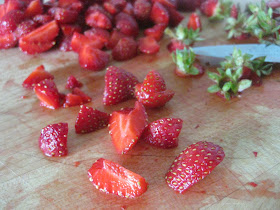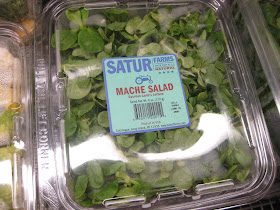This is the time of year I start seeing people hauling flats through the Greenmarket with the name Mountain Sweet Berry Farm on the side. This can only mean one thing: Tristar strawberries have arrived. I make a beeline for the stand and get in a long line to buy my pints of berries. Some things in life are worth the wait and I’m telling you, this is one of them.
The Tristar is a great example of science improving upon nature. The USDA found a wild strawberry plant near Salt Lake City, Utah and successfully crossed it with several commercial varieties to propagate this natural hybrid for public use. Very popular in cooler climates like the Northeast, Tristars are day-neutral, meaning the plants bear fruit throughout the growing season. Other types of strawberries are early-bearing/June-bearing, which fruit once a season and produce the largest berries, and ever-bearing, which bear small to medium size fruit, twice a season.
Specific climate and conditions are required for the plant to thrive but the rewards for such tender loving care are great; the small to medium-sized Tristars possess the heady fragrance and intense, sweet flavor of wild strawberries. Watch this video of none other than Rick Bishop himself for a more in-depth discussion on why Tristars are so fabulous.
Before I even got to the head of the Mountain Sweet Berry line I knew what I was going to do with my berries: ice cream. Somewhere in my recent past I had a really delicious strawberry ice cream and it’s been in my mind as soon as Tristars come into season, I was going to make my own.
Now all I needed was a recipe and I knew just who to turn to. Frank Stitt is one of my favorite chefs even though I’ve never eaten in any of his Birmingham restaurants. Pick up either (or both) of his cookbooks and I think you’ll understand why I’m a fan. He combines a sophisticated culinary background (Chez Panisse, assistant to Richard Olney in Provence) with a simple yet spectacular use of the local bounty of his home state, Alabama. If anyone is heading to Birmingham, please let me know; I’d like to tag along.
Strawberry Ice Cream
Over the years I’ve had trouble with the consistency of my homemade ice cream. The flavor is fine but the texture is, for lack of a better word, greasy. I googled my problem and found out I’m not the only one with this kind of result. The consensus seems to be I’ve been over churning. Rather than churn for the full 25 minutes suggested in my ice cream machine manual, I stopped at 18 minutes and eureka!, problem solved.
Use the best milk and cream you can find/afford; for me that means Milk Thistle Farm.
Lastly, adding fruit to ice cream can be tricky; the water content in fruit can freeze and cause water crystals to form. In an attempt to avoid that, I mashed the strawberries a bit with the back of a spoon and, at the suggestion of Chef Stitt, macerated the strawberries in sugar to help break down the fruit. The result? No ice crystals.
1 ½ cups chopped, ripe strawberries
½ cup plus 1 tablespoon sugar
2 cups half-and-half
½ vanilla bean, split
6 large egg yolks
1 cup cold heavy cream
Place the strawberries in a bowl and toss with the 1 tablespoon sugar. Mash slightly. Set aside to macerate for 30 minutes.
In a large nonreactive saucepan, combine the half-and-half, the ½ cup sugar, and the vanilla bean and bring to a boil. Immediately remove from the heat, cover, and let steep for 10 minutes.
Meanwhile, whisk the egg yolks in a medium bowl until thick, about 3 minutes.
Temper the egg yolks by gradually adding about ½ cup of the warm half-and-half, whisking constantly. Transfer the yolk mixture back to the saucepan and cook over medium heat, stirring constantly, until the custard begins to thicken. It should register 176 degrees Fahrenheit on an instant-read thermometer or coat the back of a spoon.
Immediately strain the custard into the bowl of strawberries and add the cold cream. Cover and refrigerate until thoroughly chilled.
Freeze the ice cream in an ice cream machine according to the manufacturer’s instructions. Transfer to a freezer container and freeze for an hour or two to firm before serving.































